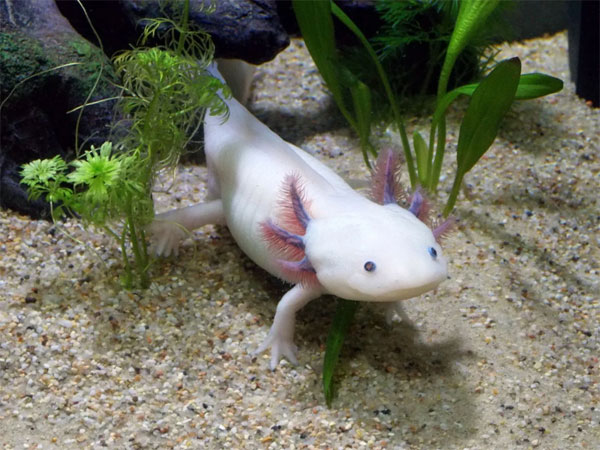Study finds new clue to limb regeneration using genetically modified glowing axolotls

[A photo of an axolotl. Photo Credit to Wikimedia Commons]
A study of axolotls has provided scientists with new clues into the mystery of limb regeneration, potentially bringing researchers closer to understanding how such abilities might one day be applied to human medicine.
Axolotls are aquatic salamanders that have become popular aquarium pets and pop culture icons due to their cute appearance.
These animals possess the ability to regenerate entire limbs.
For this reason, scientists have studied axolotls for years as a potential key to unlocking limb regeneration in humans.
In a study published in Nature Communications, researchers genetically engineered axolotls to glow in the dark to better understand the molecular underpinnings of their regenerative abilities.
“A longstanding question in the field has been, what are the cues that tell cells at the injury site to grow back just the hand, for example, or to grow back an entire arm,” said senior study author James Monaghan.
The axolotls’ ability to regenerate extends beyond limbs to include tissue in the heart, lungs, and even the brain.
This capability is possible due to a substance called retinoic acid that signals which body parts an injured axolotl cell should regenerate.
Scientists genetically modified a group of axolotls to glow fluorescent green to track retinoic acid signaling when an injury was inflicted.
When researchers injected high concentrations of retinoic acid into an injury site, they observed rapid and extensive growth of cells.
“We discovered that a single enzyme is responsible for breaking down retinoic acid in axolotl bodies,” Monaghan said.
The study found that an enzyme called CYP26B1 blocks regeneration from exceeding the restoration of an injured area to its original state.
These findings are small but vital pieces in solving the puzzle of the axotol’s regenerative system.
The next step is to identify how retinoic acid influences specific genes inside cells during regeneration.
Humans also have retinoic acid during the embryonic stage to direct cells on where to grow different parts of the body.
However, human cells eventually stop responding to these signals before birth.
Retinoic acid, a derivative of vitamin A, is related to retinol, already used in skin-care products for its regenerative properties.
“While we are still far from regenerating human limbs, this study is a step in that direction,” said Prayag Murawala, an assistant professor at MDI Biological Laboratory in Maine.
Axolotl cells react to injury by dedifferentiation, a process of reverting to an embryonic state, guided by retinoic acid to rebuild lost and damaged cells.
Human cells, by comparison, use collagen to fill in damaged or missing areas with brand new cells without any specific instructions.
Murawala further added that the key to unlocking regenerative capabilities in humans involves knowing the right chemical signals to reactivate developmental instructions.
“We all have the same genes. We’ve all made these limbs when we were embryos,” he stated.
In recent years, axolotls have exploded in popularity among the general public as well as within the scientific community.
Although full human limb regeneration is likely yet to come any time soon, the increasing popularity of these aquatic salamanders has also drawn greater interest in research of these curious creatures and their potential applications.

- Joonpyo Kim / Grade 12
- Haven Christian School

![THE HERALD STUDENT REPORTERS [US]](/assets/images/logo_student_us.png)
![THE HERALD STUDENT REPORTERS [Canada]](/assets/images/logo_student_ca.png)
